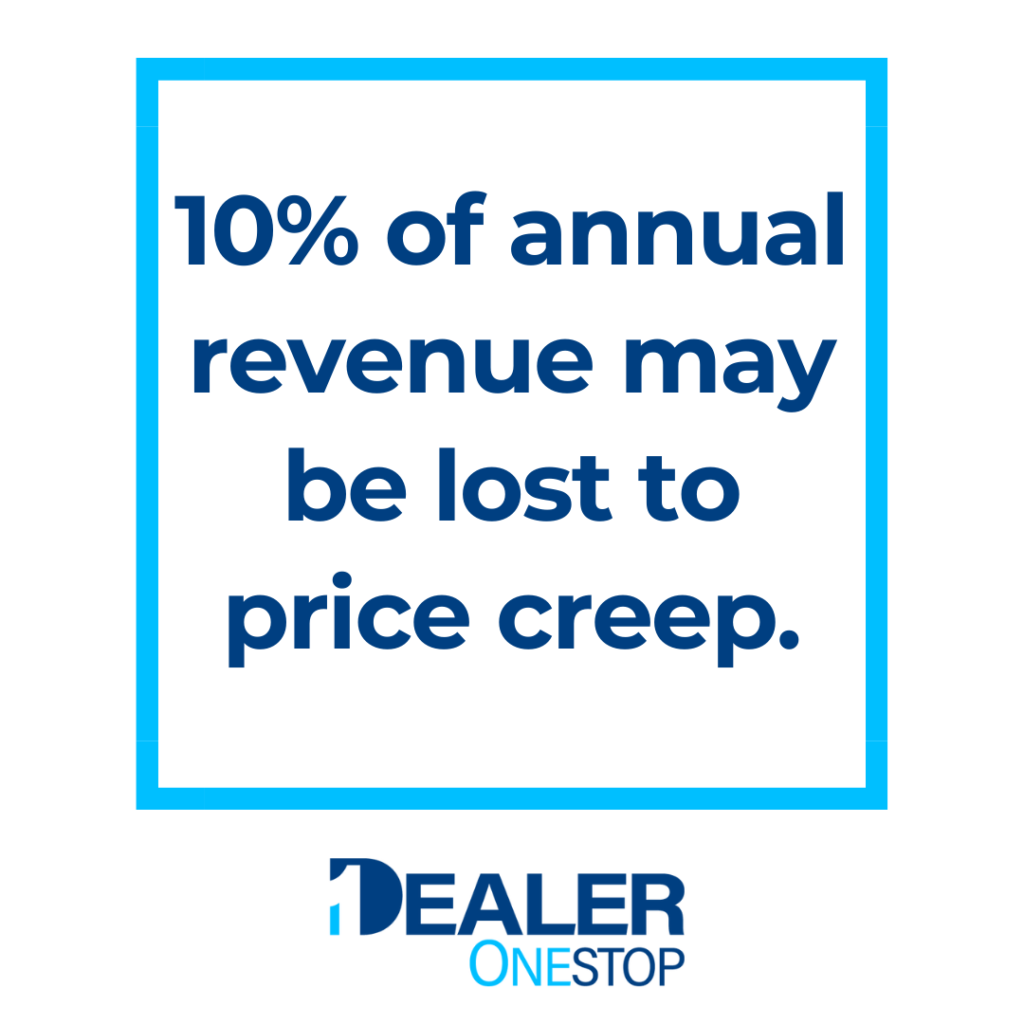In automotive retail, a nuanced challenge like price creep can dramatically impact financial stability. Price creep, defined as a subtle yet consistent cost increase, often goes unnoticed amid daily operations yet significantly erodes profit margins. Across various business facets, from parts inventory to service rates, the effects of price creep can forge a silent but damaging path.
 Analyzing dealership numbers, NADA reveals a concerning pattern—up to 10% of annual revenue may be lost to price creep. Understanding and addressing these concealed speed bumps is essential for healthy dealership economics. Identifying and acting on these creeping costs is critical for thriving in the competitive automotive industry.
Analyzing dealership numbers, NADA reveals a concerning pattern—up to 10% of annual revenue may be lost to price creep. Understanding and addressing these concealed speed bumps is essential for healthy dealership economics. Identifying and acting on these creeping costs is critical for thriving in the competitive automotive industry.
With the right strategies and vigilance, dealers can combat price creep. The focus is on building defenses to maintain long-term financial success, not merely identifying cost increases.
Countering Cost Inflation in Auto Sales
Price creep in auto dealership finance is akin to a slow leak that drains profits over time. While starting insidiously with small increments, if unchecked, it accumulates stealthily. For example, if ignored, a slight uptick in utility rates or routine vendor service fees can significantly amplify operational costs. The dealership’s proactive stance is essential for managing cost inflations.
Auto dealerships face the ongoing task of vigilantly assessing and adjusting contract terms in response to vendor pricing shifts. Another scenario could be software license renewals, where unnoticed changes can inflate costs for key management systems. Missing these financial shifts can lead to steady fiscal health erosion, undermining market positioning.
Attention to financial details goes beyond administrative tasks—keeping a dealership’s offerings attractively priced and ensuring long-term economic status is essential. Constant vigilance allows a dealership to thrive despite price creep, ensuring competitiveness and customer satisfaction.
Streamlining Operations in Automotive Dealerships
Operational efficiency is crucial for financial success in automotive dealerships. Disorganized processes can lead to contracting mistakes, resulting in financial loss. For instance, failing to renegotiate service contracts can lead to continued high-rate payments. Effective contract management involves consistently tracking and managing key contractual details.
Efficiently organized contracts enable dealerships to find and act on cost-saving opportunities or better terms swiftly. For example, having the chance to switch to a more cost-effective insurance provider can cut overhead costs. Aligning operational efficiency with financial optimization is crucial for a dealership’s success.
Well-managed contracts can also provide leverage in negotiations. Dealers with documented prompt payments can use that history to negotiate lower interest rates on lines of credit. Strategic contract management is critical to protecting a dealership’s economic interests.
Overcoming Departmental Silos in Auto Dealerships
In the dealership setting, fragmented oversight in contractual matters due to departmental silos can indirectly increase costs. Siloed departments might overspend due to a lack of inter-departmental communication. For example, a marketing team may exceed the financial team’s budget due to misalignment. Centralized oversight can proactively prevent these slips.
Open communication across departments aligns contract management with broader financial goals. Collaborative interactions, such as between the purchasing and service departments, can lead to advantageous deals like bulk discounts. Unified actions are necessary to secure a dealership’s economic well-being against unforeseen price increases.
Adapting Dealership Contracts for Market Changes
Ensuring dealership contracts remain adaptable to ever-changing market conditions is essential for sustaining competitiveness. Adhering to outdated contracts carries a significant risk; it diminishes a dealership’s ability to negotiate effectively and exposes the business to unnecessary cost escalations. By proactively reviewing and revising contract terms, dealerships can defend against these fluctuations, securing their financial stability and operational resilience.
Adaptability in contract management fortifies a dealership’s position in a volatile market, safeguarding its economic well-being. This dynamic approach to contract oversight prevents the dealership from falling victim to unfavorable terms that could impede growth. A dealership maintains its competitive advantage through this strategic adaptability, ensuring its long-term success amidst market challenges.
Challenging Extra Costs in Auto Dealership Management
Hidden costs, particularly in areas like shipping and vendor services, can significantly challenge a dealership’s financial health. Proactively addressing these costs can save a dealership an average of 5% in operational expenses annually. Implementing a policy of transparency with vendors and communicating openly about potential fee changes is crucial. This approach cultivates trust and protects against unexpected increases contributing to price creep.
Effective fee management is vital for automotive dealerships to mitigate the impact of additional costs. A dealership strengthens its defenses against unforeseen financial pressures by fostering open dialogues with vendors and customers concerning fee adjustments. Ensuring clear, upfront conversations about cost alterations allows for better budgetary control and aids in maintaining a competitive edge in the market.
Tackling Price Creep in Auto Dealerships
Guarding a dealership against price creep requires proactive, deliberate actions. Implementing these strategies ensures control over finances:
- Vigilant Oversight and Review: Keep an eagle eye on vendor contracts and be alert to changes in pricing.
- Centralize Vendors and Contracts: Consolidate contracts for a streamlined approach, potentially reducing vendor numbers and easing administrative loads.
- Transparent Relationship Building: Promote transparency for clear communication on pricing alterations.
- Regular Market Analysis: Periodically assess the market to keep pricing competitive.
- Vendor Performance Evaluation: Routinely scrutinize vendor performance, ensuring value and opportunity for renegotiation or discontinuation.
Deploying these practices equips dealerships to counteract the subtle pressures of price creep.
Ensuring Profitability Against Hidden Inflation
Combating price creep is not just a reactive measure but a strategic necessity for preserving financial health and ensuring competitive longevity. The insights shared underline the critical nature of vigilance and adaptability in dealership operations. By implementing comprehensive strategies—from rigorous contract management to fostering transparency with vendors and customers—dealerships can effectively mitigate the insidious effects of price creep. These actions safeguard current profit margins; they lay the groundwork for sustainable business practices that adapt to market changes and operational challenges.
Ultimately, an auto dealership’s success in navigating the complexities of price creep hinges on its commitment to continuous improvement and strategic foresight. The practices outlined, including vigilant oversight, centralized contract management, and proactive market analysis, serve as a blueprint for operational excellence. Embracing these principles enables dealerships to counteract price creep and capitalize on opportunities for growth and innovation. In doing so, dealerships can thrive, balancing customer satisfaction and financial stability in an ever-evolving market landscape.
CLICK HERE to get the full 10 Auto Dealership Blind Spots Causing Profit Leaks Report.








